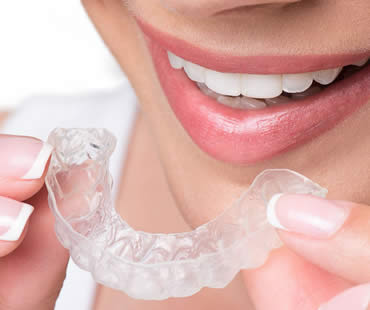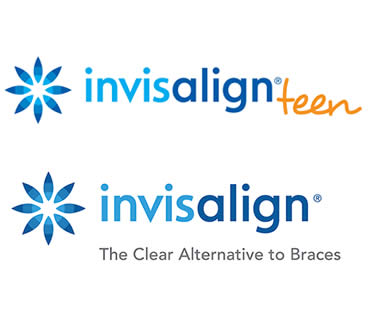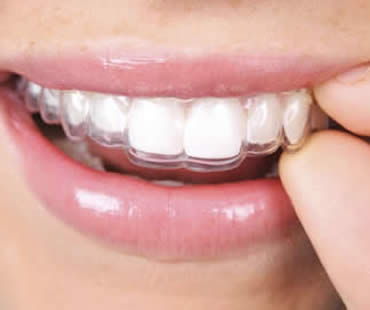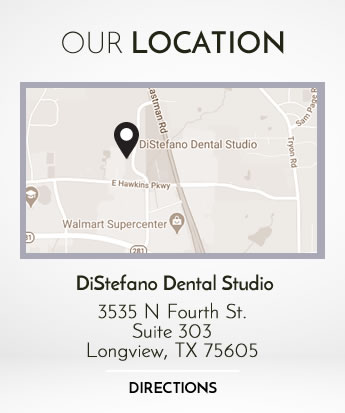
Does your child need braces, but isn’t sure about being a “metal mouth” for two or more years? Did your teen come to you and beg for some other option to traditional braces? Perhaps you’ve heard about Invisalign aligners but are wondering if they’ll work for your child. Invisalign is absolutely appropriate for your teen if all of his or her baby teeth have fallen out and adult teeth have erupted.
Invisalign provides the same results as traditional metal braces, but without the metal brackets. Concerns over eating with braces are removed with the Invisalign trays, as they come out for meals, leaving your teen free to eat any food he or she desires.
Invisalign utilizes clear plastic trays that allow the process of straightening your teen’s teeth to be less obvious and less obtrusive. Beginning with x-rays and molds, your orthodontist will make a series of trays, called aligners. These trays are worn most of the day, taken out only to eat or to be cleaned. The process of straightening happens gradually and comfortably.
It is essential during this time that the trays are worn as recommended by the orthodontist. Wearing them less than the recommended amount of time will result in slower correction, and has the potential to lengthen treatment. Have your teen continue with any established good oral hygiene habits. Brushing and flossing must continue on a regular basis, brushing twice a day at minimum and flossing before bedtime.
Being a teenager is full of difficulties, and it is during this time that teens are at their most self-conscious. Adding metal braces to this transition can make everything worse for your child, leaving him or her self-conscious about eating with friends or smiling, talking or laughing in public. Your teen’s gapped, misaligned or crowded teeth can be improved significantly with Invisalign trays. Talk to your orthodontist today to see how Invisalign can make a difference for your child.
We treat patients from Longview and the surrounding area

Modern technology is constantly making strides in improving dentistry, and the area of teeth straightening is no exception. In order to get your dream smile, you don’t have to be stuck with a mouth full of unsightly and uncomfortable metal braces any longer. Transforming your smile is now possible with a hidden product called Invisalign.
Also referred to as invisible braces, Invisalign utilizes clear plastic aligner trays to move your teeth into better positions. The series of customized trays are fitted for your mouth to gently move your teeth over time. Because they are created specifically for you, they are more comfortable than you might think and achieve their goal with minimal soreness. This is a great benefit over the painful and irritating process of traditional braces.
Wearing the clear aligners gradually shifts your teeth, and every few weeks your dental professional provides a new set of aligners to continue moving your teeth toward the final goal. This process is repeated until your teeth have moved into their desired positions, giving you a straight and attractive new smile. The aligners should be worn about 22 hours a day for best results.
Patients of all ages may be candidates for Invisalign. This technology is appealing to adults because it avoids the embarrassment of noticeable braces during professional and social encounters, and with teens who want to avoid the ridicule of a metal smile during an often emotional time of life. There is even a special version of Invisalign made for teens, which has a blue-dot display to remind the young adults about consistent wear and when it’s time to switch trays.
One of the other major benefits of Invisalign is that the trays are removable, making eating and hygiene easy. There are no diet restrictions like with traditional braces, and the cleaning hassles of metal brackets and wires does not exist.
If you are wanting to improve your smile with orthodontics, consider the revolutionary solution of Invisalign. It can keep you smiling throughout the entire process.
Our dental office is located in Longview

Your smile is a noticeable part of your appearance, and yellow dingy teeth can leave a negative impression on others. Most people have to work at having a bright sparkly smile, because teeth can discolor with age, diet, and lifestyle.
You may not realize that sipping a glass of red wine or coffee can be a detriment to your smile, as can sugary items that allow acids to attack your tooth enamel. Smoking is an even worse culprit. It not only leaves ugly spots on the surface of teeth, it also contributes to poor gum health.
If your teeth are already stained or if you’re having a hard time breaking the habits that discolor them, teeth whitening is a good way to improve the look of your smile. There are numerous methods to regain the natural glow of your teeth, ranging from over-the-counter techniques for home use to professional treatments in an office setting.
Whitening products available at your local drug or grocery store include things like toothpaste, chewing gum, mouthwash, gels, and whitening strips. These are readily available and usually inexpensive options. Most of these products are simple to use and can be done in the convenience of your home when you choose. However, over-the-counter products are not as strong as professional methods. This means that results are not dramatic and usually take a long period of time of consistent use. Also, the effects may not last as long as you hope before it’s time to consider whitening again.
Professional teeth whitening is often performed by general and cosmetic dentists in an office environment. Bleaching is a popular professional method. The biggest advantage of in-office treatment is the fast results, with a visibly brighter smile evident in about an hour. Results are often dramatic, lightening teeth by several shades. Professionals trained and experienced in these methods provide safe and effective treatment. Methods available professionally may cost a bit more than home options, but the dramatic results may be worth it.
Our dental office is located in Longview

It’s a fact of life that teeth can become dingy and yellowed through the years. Your diet, age, personal habits and more affect the shade of your teeth. Even with the best care, it’s nearly inevitable that at some point you’ll want to brighten your smile. Once you pursue teeth whitening, you’ll want to be sure to make your new smile last as long as possible.
Over-the-counter products are readily available from your local drugstore and simple to use. However, they can take a long time to obtain full results and even then, you may not achieve the desired shade you’d like. Professional teeth whitening is the fastest and most dramatic way to brighten your smile.
If you spend the time and money to whiten your teeth professionally, making it last will be important to you. Results can last for a long time, but probably not forever. Here are some tips for making your white teeth last longer:
- Watch your diet especially carefully for the first 48 hours following treatment. Your teeth are at the most risk for staining during this timeframe.
- For the first few days, avoid eating known staining foods like blueberries, beets, dark soups, marinades, sauces, curry or tomato products.
- At first, avoid broccoli, green beans, peas, sprouts, corn, or skinned potatoes. These have increased risk of particles getting stuck into the highly susceptible tooth pores after whitening treatment.
- Watch out for citrus fruits that are high in acidity, which can also make your saliva more acidic. Your teeth are more prone to damage from acid when they already have increased sensitivity from the whitening chemicals.
- Avoid drinking dark colas or coffee, since both can stain your teeth no matter when you drink them.
- Get in the habit of drinking from a straw so that dark colored drinks don’t come into as much contact with your teeth.
Choosing the right foods and drinks after teeth whitening can make a big difference in the length of time your teeth stay white. Make the best decisions to enjoy your bright smile.
If you live in the Longview area contact us today

The innovative approach to improving smiles through Invisalign has paved the way for beautiful smiles for people of all ages. Not just for children and teenagers, Invisalign appeals to adults all the way through to retirement ages. It’s never too late to transform your smile and regain your self-esteem when you have the option of Invisalign.
What types of problems does Invisalign address? In addition to simply straightening the teeth to achieve a more perfect smile, dental problems like gaps, overcrowding, overbites, underbites, open bites and cross bites can all be improved.
The process involves wearing customized invisible plastic aligners over your teeth. New aligner trays are provided every few weeks during treatment as your teeth gently move to their improved positions. The aligners are removable for easy dental hygiene, since normal brushing and flossing are possible instead of dealing with cumbersome wires and brackets. The clear plastic trays are nearly invisible in your smile, hugging your teeth securely allowing for no embarrassing slips or speech impacts.
Invisalign is possible for just about anyone with permanent teeth and healthy gums. Older patients are often at higher risk for gum issues, so correcting crooked teeth or overlaps is especially beneficial to help those patients avoid gum problems related to gaps or inability to clean teeth properly. Correcting misalignments can also prevent jaw or joint pain in the mouth, head, and neck area.
Patients over the age of 50 are seeking orthodontic treatment more than ever. As they age, many people want to avoid dentures when possible and Invisalign can provide a great option for making smiles look more appealing while also improving oral health. A beautiful smile can also improve your outlook on life, making you look and feel younger. An attractive smile positively impacts your overall attitude and appearance, and it’s possible with the help of Invisalign.
Schedule your appointment at our Longview dental office

One of the most recent innovations in modern orthodontics is Invisalign. These unique clear aligners are becoming increasingly popular for improving smiles without the stigma associated with traditional braces. Invisalign aligners straighten teeth by placing gentle pressure on them to move into better positions. This solution offers distinct advantages to some of the other options in orthodontics.
Hidden appearance:
One of the most obvious benefits of Invisalign is that the clear plastic is practically invisible in your mouth. The subtle appearance of the retainers is much less obtrusive than traditional metal braces. For patients who want to diminish the fact that they are undergoing orthodontic treatment, Invisalign in the perfect solution. Personal and professional relationships are not at risk of embarrassment due to being self-conscious about your smile.
Easy removal:
You will remove aligners from your mouth when eating or performing oral hygiene tasks. There are no impacts to your diet during Invisalign treatment, since you take out the aligners anytime you eat. Brushing and flossing are performed normally without having to worry about cleaning food debris out of intrusive wires and brackets. This can have positive impacts on your oral health as well.
Increased comfort:
The lack of metal pieces in the aligners means a more comfortable experience. Traditional braces have a reputation for poking the mouth or breaking. Invisalign offers a clear advantage of being very comfortable when worn.
Boosted confidence:
No matter if you are a teenager or an adult wearing braces, it can be embarrassing to have a mouth full of metal in your smile. The invisible quality of Invisalign eliminates those self-conscious feelings, giving you the confidence to smile, laugh and eat as usual even while undergoing treatment.
If these benefits of Invisalign sound appealing to you, schedule an appointment with a qualified orthodontist who provides this type of treatment. It may be the winning route to your beautiful smile.
Our dental office is located in Longview









